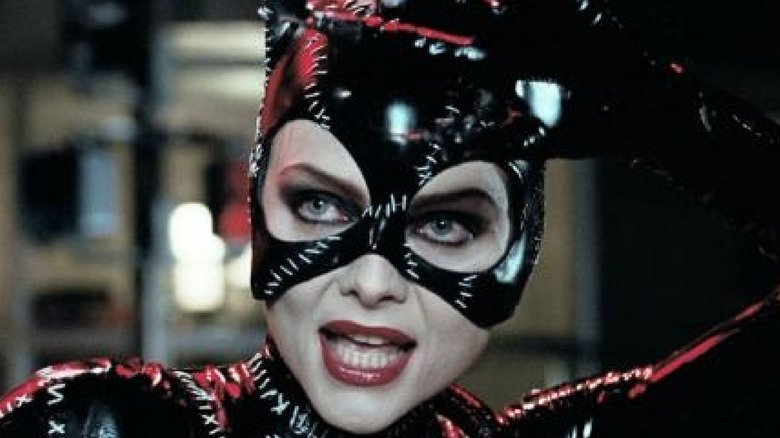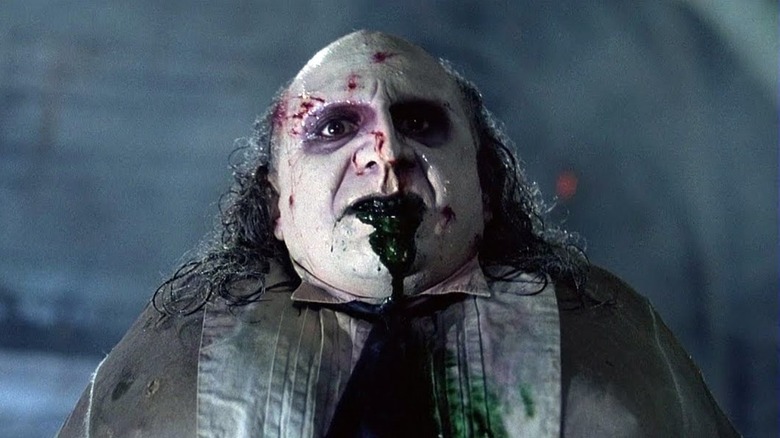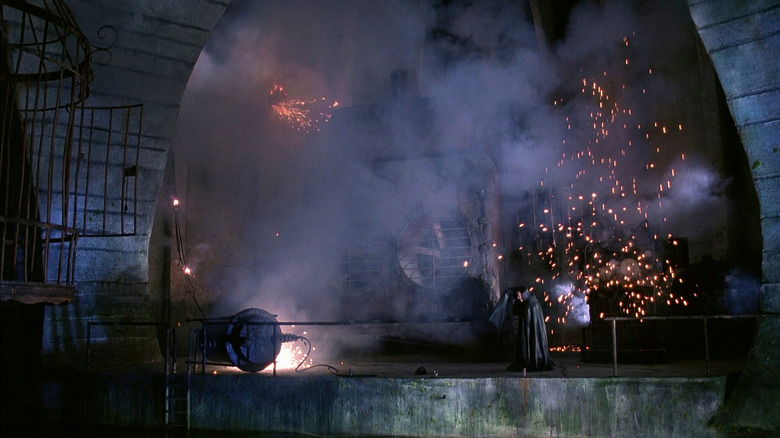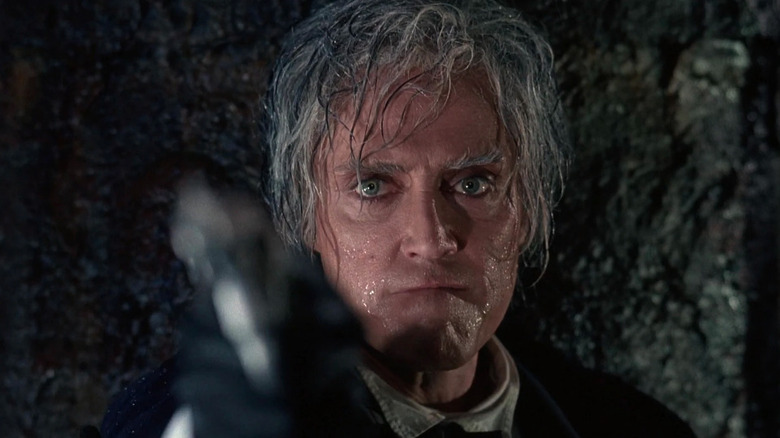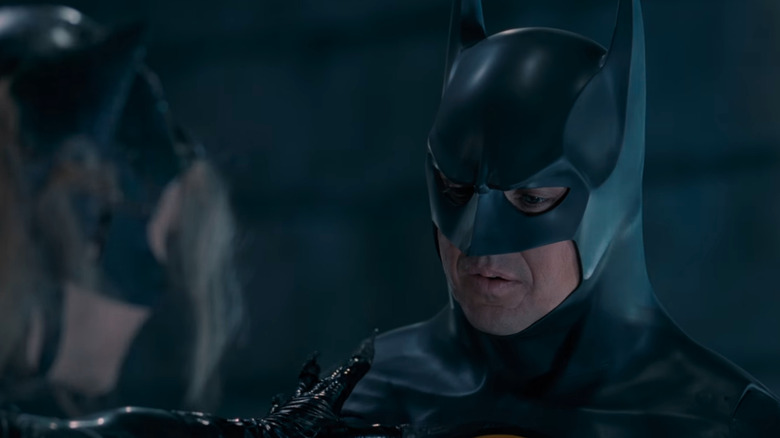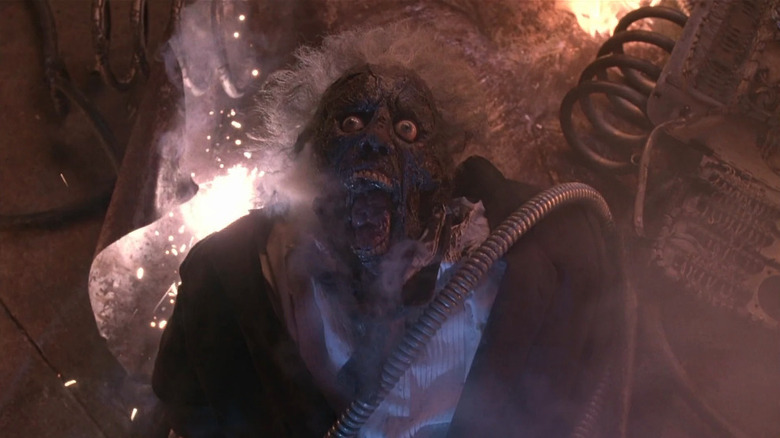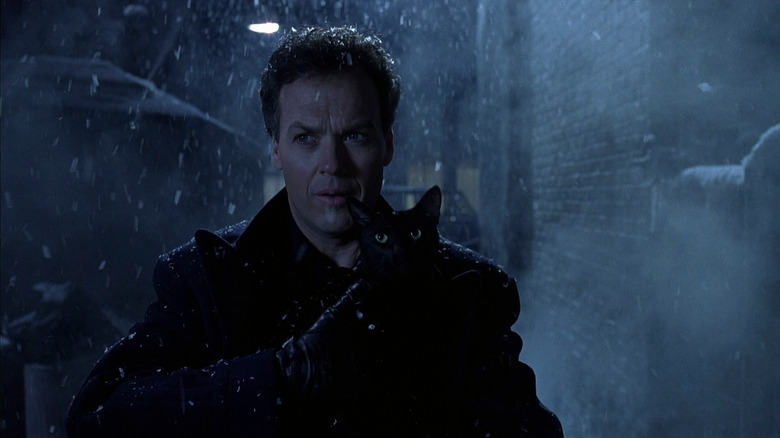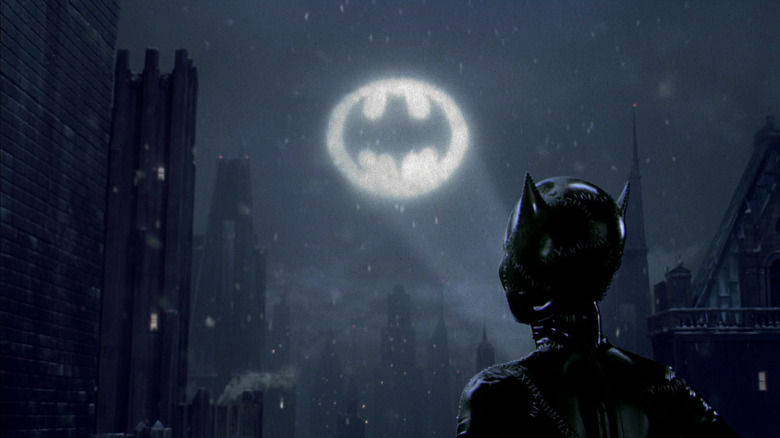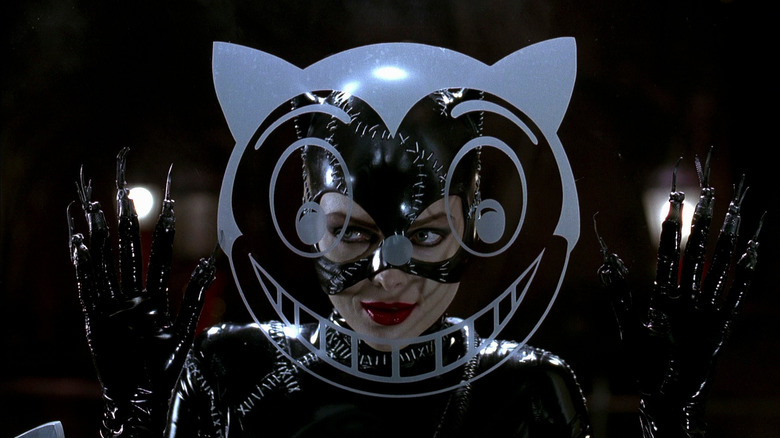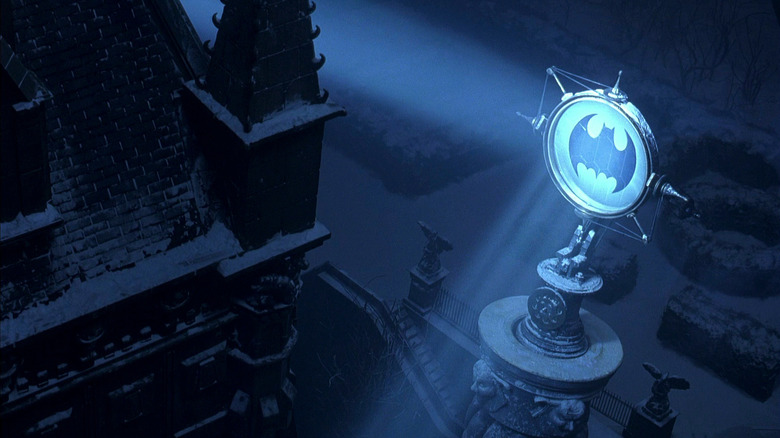The Ending Of Batman Returns Explained
How do you follow up the critical and commercial success of 1989's "Batman?" Why, with a sequel about a power-hungry, face-munching, sewer-dwelling penguin man (Danny DeVito) who steals all of Gotham's first borns, of course. Throw in a tragic storyline about a mentally fragile office worker (Michelle Pfeiffer) who returns from the dead to make her evil boss pay for his crimes and you've got yourself a sequel every bit as memorable as its predecessor.
Indeed, "Batman Returns" is something of an odd duck (much like the massive inflatable rubber ducky that acts as its antagonist's vehicle of choice). It's dark. It's violent. And it's overwhelmingly morose.
But with films like this, it's often all about the ending. Will the hero and villain live or die? How can Catwoman get her comeuppance and still emerge as a not-really-bad guy? With Burton clearly striving for a darker tone, how does that impact studio-mandated desires for a sequel set-up? For any early '90s blockbuster tentpole, there were many masters to serve, many contradicting each other.
As it exists, the film's ending is a minefield of melodrama and melancholy. From unexplained fluids to seemingly random murder attempts, the ending of "Batman Returns" is about as twisty as those spirals of which director Tim Burton seems so fond. Without further ado, here's a breakdown of the ending of this pitch-black superhero flick.
What is that green guck?
The Penguin's death scene is odd for a number of reasons — What kind of weirdo emerges from the water with their eyes open? Why does this man keep his deadly umbrellas and his cute umbrellas in the same bucket? — but the weirdest thing element might be the green slime that trails out of the his mouth. Although there might have been a foreshadowing trickle here and there throughout the film, Penguin suddenly turns into an emerald waterfall.
So, why is there green ichor pouring down the Penguin's chin? Perhaps it was a way to appease the MPAA, perhaps it simply looks cool (which it does). Burton's work has always owed German Expressionism, and "Batman Returns" is no exception. The artistic movement sought to represent psychic and subconscious realities as well as fleshy ones. So, maybe Cobblepot's forest-green slime mouth "makes sense" in the same way that your teeth falling out in dreams makes sense.
That said, there are a number of "rational" answers. As one respondent mused on Quorra, the green liquid could be a sign of sulfhemoglobinemia, a symptom of pollution exposure ... which wouldn't be that improbable for a man who has spent most of his life living in sewers. It could also point to something being really, really wrong with his liver or spleen — though if that's the case, the green runoff is the least of his concerns.
Side note: In real life, the green stuff was a good palate-cleanser for all the raw fish Danny DeVito was eating on set. "In the middle of the action," he said in an interview, "I would squeeze a mixture of mouthwash and spirulina into my mouth — but that was because I needed to ooze this green, kind of black thickish liquid out of the corners."
Batman does nothing during the final confrontation
"Batman Returns" is pretty unconventional, as far as Caped Crusader adventures are concerned. The Dark Knight isn't cracking quips while kick-flipping bad guys; there is no batusi or shark repellent here. This is because "Batman Returns" isn't really Batman's movie; it is Catwoman's movie.
Take the film's finale, where Batman is more of an audience member than an active participant. He spends most of the three-way confrontation between Max Shreck, the Penguin, and Selina Kyle moping in the corner, ineffectively trying to diffuse the situation with platitudes rather than fists.
In this moment, Bruce Wayne/Batman becomes more of a depressed hostage negotiator than an action hero, cowering when the sparks fly and covering his face rather than cracking skulls. It's like Selina says: "Don't pretend this is a happy ending."
Flashy heroics have no place here, which gels nicely with the dark, morose vibe of the film as a whole. He stays out of the way while Selina reaches the conclusion of her narrative ark, achieving her revenge, and vanishing into the night in a puff of smoke.
Shreck shooting Batman doesn't make sense
On one hand, Max Shreck asking a bare-faced Bruce Wayne why he's dressed up like Batman is very, very funny. On the other, what happens next makes absolutely no sense. After Selina enlightens her previous employer that Bruce Wayne is dressed like Batman because he is Batman, Max immediately takes out his gun and shoots the Caped Crusader in the shoulder.
Narratively speaking, it's useful to have Batman out of the picture while Max and Selina have their confrontation. While this Batman isn't exactly a man of action, if he weren't incapacitated, perhaps he might do something about Max pumping his lady friend full of lead. Then again, given how trigger-happy Max is with Selina, maybe he just couldn't wait to get his gun out and start shooting, and Bruce just happened to be in the way.
But, if you think about it, Max shooting Batman/Bruce Wayne doesn't really make any sense. Was Bruce Wayne stonewalling Max's power plant enough to drive Max to murder one of the most prominent men in Gotham? He killed Selina without a second thought, but surely he'd think twice about offing such a high-profile socialite ... especially when that high-profile socialite is also a masked vigilante who could beat him up. Max's decision to shoot Batman/Bruce becomes even more confusing when you consider that he just dispatched the one man who could have saved his life.
Because of that pesky moral code of his, Bruce is super invested in Selina not killing Max. How is Max killing his only ally a good idea? Then again, he couldn't even put two and two together that Bruce Wayne was Batman when the man was standing unmasked right in front of him. So, maybe the real answer is simply that Max isn't the brightest bulb in the chandelier.
Batman's eye makeup disappears when he takes off his mask
These days, mask-wearing superheroes are more upfront about what goes on behind the mask. Which is to say: eye makeup.
In "Kick-Ass," Nicolas Cage's Batman-inspired Big Daddy applied dark liquid paint around his eyes before donning his mask. More recently, Robert Pattinson's Batman embraced his raccoon eyes like a bonafide goth, and it looked pretty cool.
Back in the day, superhero films didn't seem to think the audience could handle the reality of a bare-faced Bruce Wayne sporting two black eyes. Case in point: the final act of "Batman Returns." In a dramatic (if ultimately unsuccessful) attempt to talk Selina Kyle off the "murder is good" ledge, Batman removes his cowl. Okay "removes" is burying the lede: he rips it off like it's fruit leather. Isn't that thing bulletproof? How strong is Bruce Wayne?
Back on topic: if you're paying close attention and not getting too wrapped up in the doomed romantic gesture of it all, you'll notice that somehow Bruce Wayne's eye makeup magically vanishes when he removes his mask.
Maybe the filmmakers didn't think anyone could take these drama-filled final moments seriously if Bruce Wayne looked like he was late for a Cure concert. The moment is a pretty impressive case of sleight of hand — and now that it's been pointed out, you'll never again be able to not notice it.
Burton really likes electrocuting characters
Burton gets a lot of creative inspiration from the circus (Beetlejuice turned himself into a merry-go-round, "Dumbo" and "Big Fish" both were set there), and his two "Batman" films go back to the pine-striped well a couple times.
Step right up and gape at one of Burton's recurring gags: a villain getting electrocuted beyond recognition. It's a devious joke, like an amusingly violent Looney Tunes gag twisted by a harrowing sense of realism. In 1989's "Batman," Jack Nicholson's Joker feigns camaraderie with Antoine Rotelli, the crime lord who refuses to take orders from the obviously criminally insane Jack Napier. But a handshake's a handshake, right? Unfortunately for Rotelli, the universal sign of mutual understanding takes a dark turn when smoke begins to fly out of his palm. Soon enough, the Joker's concealed joybuzzer from hell has reduced Rotelli to a human-shaped lump of charcoal.
Burton pulls a similar carnival gag in the finale of "Batman Returns." While you'd think Selina Kyle would try and find a way to electrocute the man who killed her without kissing the guy, she's a woman with a sense of aesthetics, so an electrified kiss seals the deal. Once the smoke has cleared, Max Shreck's toasty body looks like a high-priced ornament from Spirit Halloween.
Bruce adopts Selena's black cat
After Oswald Cobblepot's limp, long-john-wearing corpse drifts unceremoniously through the Gotham zoo's penguin enclosure, a jump cut into the near future reveals Bruce and Alfred driving through the back alleyways of their snow-covered city. After spying what is (rather obviously) a slinking slender figure outfitted in a tight-fitting catsuit (who could it possibly be?), Wayne hops out of his Rolls-Royce in hopes of being reunited with the kinky cat lady he presumed dead. Finding the alleyway empty, Bruce hangs his head, dejected at the realization that he's probably just imagining things. Only, what's this? An affectionate black cat! Selina Kyle's affectionate black cat.
This adorable feline is likely Miss Kitty, the cat that first approached Selina after Max Shreck pushed her out an office window. Selina's pet and the proud owner of one of the few non-pastel pink items in her owner's apartment (a velvet blue cat bed), Miss Kitty entering into Wayne's care as a memento of her dearly-departed (or so it would seem) owner is a fair tradeoff to being a glorified forget-me-not.
From Bruce's peaceful expression, it's clear that the caped crusader is picking up what Selina is putting down. She led him to her cat in order to give her a more, uh, "stable" home. More importantly, for Bruce, Miss Kitty is Selina's way of letting him know that she's still kicking. What a thoughtful Christmas gift.
The final shot was last minute and expensive
The final shot in "Batman Returns" is possibly one of the most iconic moments in any Batman film. As Bruce Wayne's Rolls-Royce drives through the snowy, shadow-filled alleyways, the camera pans upwards. A towering vertical labyrinth of skyscrapers cuts upward towards the sky. Snow gently falls across the Gotham skyline and the warm glow of the Bat signal lights up the sky. Suddenly, from the bottom of the frame, a leather cowl pops up; Catwoman is very much alive.
While it's hard to imagine "Batman Returns" ending any other way, originally, this shot wasn't going to be in the film. As detailed in the six-part documentary "Shadows of the Bat: The Cinematic Saga of the Dark Knight," the final shot was a rushed, wildly expensive last-minute addition. As the documentary explains, the addition was a studio note on the part of Warner Bros., who felt that the audience needed a less ambiguous sign that Selina Kyle survived, leaving the door open for possible return appearances.
The shot was filmed in one weekend to the tune of $250,000, accomplished with a body double since Pfeiffer was unavailable on such short notice.
"In terms of the post production of the movie, it was really scary, because we had a summer release date — you have to release these movies in the summer – and we had a very tight schedule," producer Denise Di Novi would recall years later. "This is before computerized editing, before CGI techniques ... it was touch and go for a few weeks there."
"There was one shot at the end that cost a quarter of a million dollars," recalls editor Chris Lebenzon. "With the Catwoman, keeping her alive. It was a studio note."
"I remember saying I don't think it can be done in the meeting, but we'll try," recalls the film's co-producer, Larry Franco. "It was a flurry of phone calls after that. Literally, the next day, we got Catwoman's suit out of storage and put it on somebody. It was that quick. It was like a nightmare."
It's also of the rare documented cases of studio executive notes making a film ... better?
We didn't get the Catwoman spinoff we were promised
The last frame of "Batman Returns" all but promises that Catwoman will return. Sure enough, while "Batman Forever" was in development in the spring of 1993, Warner Bros. announced that they were working on a Catwoman spin-off with Pfeiffer cast to return as the leather-clad anti-heroine. "Batman Returns" scribe Daniel Waters was hired to pen the screenplay and Burton was in talks to direct. Then the project sunk deep into the entropy-rich bowels of development hell.
As Den of Geek speculated in 2015, Waters turning in his script on the same day as the cinematic release of "Batman Forever" was a bad move. Where "Batman Forever" was bright, colorful, and (relatively) kid-oriented, Waters' script was adult-oriented and dark, with Catwoman in a Palm-Springs-type resort from hell that pushes her back into a life of crime. While Warner Bros. pursued more family-friendly Batman films, Burton and Pfeiffer moved on to different projects. (For the record, to this day, Pfeiffer is still down to slip back into the catsuit).
After clawing its way out of purgatory (purr-gatory?), the Catwoman standalone movie eventually became Halle Berry's 2004 Razzie juggernaut. With Pfeiffer gone, the feature debut (and only film since) of director Pitof quickly minted itself as one of the worst comic book movies ever made. Berry's take on the character currently maintains an 8% critical consensus on Rotten Tomatoes, which actually feels high. Critics have long bemoaned the film's soulless, unenthusiastic attempt to bring one of comic's most iconic women into the 21st Century.
The film had a different (and darker) ending in the script
The script for "Batman Returns" was penned by Daniel Waters, writer of "Heathers," "Hudson Hawk" and "Demolition Man." Looking at Waters' original script, specifically its final pages, there is a very different ending with a much stronger sense of finality.
As Batman and Alfred zip along in Bruce Wayne's Rolls-Royce, this ending would have had the caped crusader smiling cynically at the surrounding carnage. This doesn't feel like victory. Selina is dead, and the Penguin's defeat was far from heroic. Bruce Wayne responds to Alfred's ineffective condolences with a terse "sure." In the background of the night's sky, the bat signal flickers, and Batman ("pulling off his mask, becoming a moving mixture of Man and Superman") looks up as the beacon fades to darkness.
Whereas the actual ending indulges viewers with a cheeky "Don't worry, Catwoman's still alive and will probably get her own movie," in Waters' script, the story concludes with a bittersweet whimper, not an optimistic bang.
For all of its grotesque imagery and gothic themes, the ending of Burton's film is a triumphant affair, with Danny Elfman's score swelling back into the bombast of the main theme to ensure things end on a high note. Instead of Alfred's original downbeat "sorry, sir and ... Merry Christmas," the revised ending gave viewers a far more hopeful, open-ended "come what may ....and Merry Christmas, Mr. Wayne." Bruce seems down in the dumps, sure, but no more than usual.
In Waters' script, Bruce and Batman alike were to feel utterly defeated, consumed by a darkness with no end in sight – let alone a sequel.
